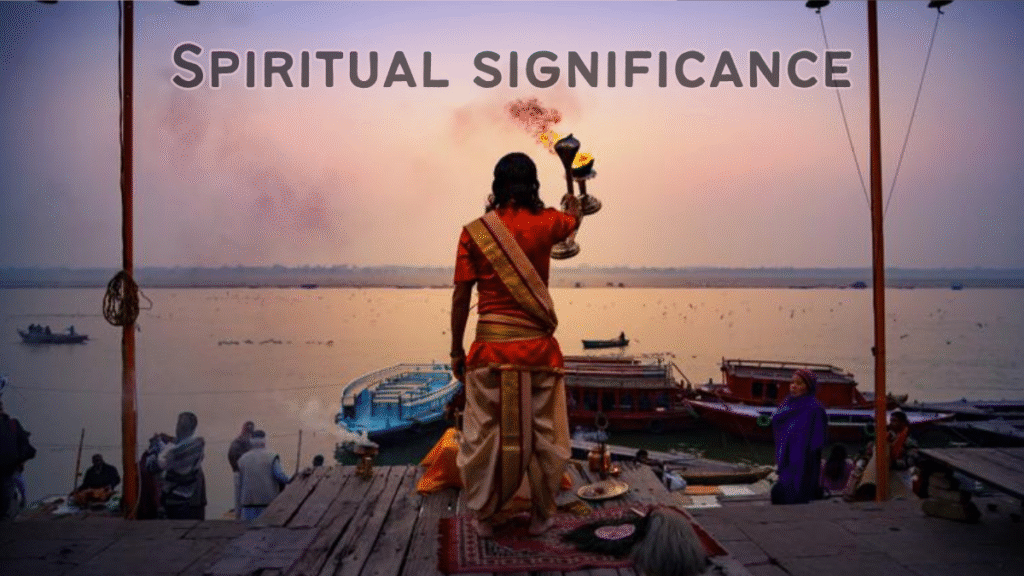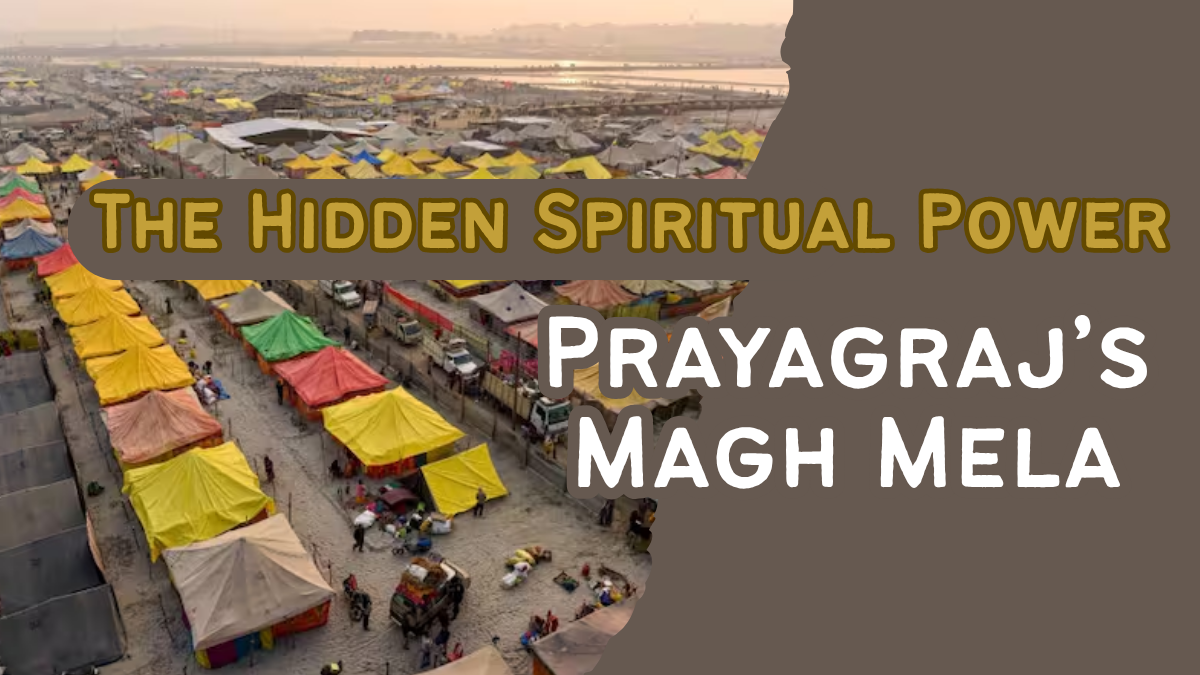Introduction
Whenever Kumbh Mela is discussed, its large form comes into everybody’s notice, but the Magh Mela organized each year in Prayagraj is not less sacred and significant than that. The fair becomes the hub of religious belief, austerity and spiritual calm at the confluence of Ganga, Yamuna and unseen Saraswati.
This fair brings together thousands of saints, seekers and devotees amidst harsh winter, who perform penance, bath and stay soaked in devotion there for a month.
What is Magh Mela
Magh Mela is a sacred bathing and meditation festival that takes place annually during the month of Magh (January-February) at Sangam’s banks. In the absence of a full Kumbh Mela, it is regarded as equivalent to Ardha Kumbh. It dates back to ancient Vedic days when the fair is a thirty-day pilgrimage that is full of spirituality, charity, religious talks and self-control.
It is not only a fair, but a ‘tapasya’, the performers of which are known as Kalpavasis. Kalpavasis take up sadhana for 30 days at the Sangam banks, observe restraint and lead pious lives.
Spiritual significance of Magh Mela

As per the Puranas, Brahma himself had conducted a yajna at Sangam that blessed this place forever. By bathing in Sangam during the month of Magh:
- One attains freedom from past life’s sins
- Forefathers achieve peace
- Mind and soul are cleansed
- One attains virtue
It is also thought that bathing at Sangam in the month of Magh provides virtue comparable to thousand yagyas and gold donation.
Sacred bathing dates
The devotees bathe during the entire month, but there are a few special days which are considered more sacred:
- Makar Sankranti – Sun’s entry into Capricorn, the first and holiest bath
- Paush Purnima – start of Kalpavas
- Mauni Amavasya – holiest bath, special significance of tarpan and silence meditation for ancestors
- Basant Panchami – adoration of Mother Saraswati and festival of knowledge
- Maghi Purnima – final important bath, culmination of Kalpavas
- Mahashivratri – Lord Shiva worship together with bathing
Who are Kalpavasis
The most unique aspect of the Magh Mela are the Kalpavasis. These are individuals who forsake worldly indulgence for a complete lunar month and perform penance on the Sangam banks. Their life is extremely austere and ascetic:
- Daily bathing before dawn
- Reading religious texts and reciting mantras
- Sleeping on the ground
- Satvik food once a day, simple
- Silence and celibacy
Kalpvaas is a type of brief sanyaas-stream, which bestows as much merit as a lifetime’s penance.
Life in Magh Mela Camps
There is a temporary city established for a few kilometers in the fair near Sangam, full of sadhus, saints, devotees and vagabonds. There are various camps and arrangements here:
Ashrams and Akharas
Well-known saint communities such as Juna Akhara, Niranjani Akhara, Vaishnav Mahasabha install tents here. They offer such activities as:
- Bhajan-Kirtan
- Sermons
- Yagya and Puja
- Free meals (Langar)
Tent Accommodation
Kalpvasis and other devotees stay in tents, where there are limited facilities but the spiritual ambiance is very deep. Environment-friendly and economic facilities are also provided in most places now.
Religious Market
Here you will get things such as religious books, Rudraksha malas, Ayurvedic medicines, and local handicrafts, so this site resembles a sacred market.
Cultural and Religious Activities

Magh Mela is not merely a bath festival, it is a colorfully diverse cultural event. There is something new every day here:
- Evenings Ganga Aarti at Ghats
- Ramayana and Bhagwat Katha
- Satsang and Bhajans by saints
- Mythological plays performed on stage
- Free education and medical service camps
The experience of all this makes the mind peaceful and reverent.
Sangam Bathing Experience
The core of Magh Mela is the sacred bath in Sangam.
How is the bath done:
- Devotees travel by boat to the Sangam place in the early morning hours
- They then take a dip thrice and recite mantras after reaching there
- They do tarpan and pinddaan for their ancestors
- Some individuals even take Gangajal home
Taking a dip in the early morning cold, the first light of the sun, the chanting of mantras and with a multitude of devotees is an extremely spiritual and emotional experience.
Magh Mela mythological beliefs
It is said in most books such as Skanda Purana, Matsya Purana that in the month of Magh gods themselves descend to earth to bathe at the Sangam. It is said that sages, gods and ancestors too are present at the Sangam in unseen form at this time.
This festival is also a reminiscence of these sacred stories:
- The severe penance of sage Markandeya
- King Bhagirath’s atonement, by which Ganga descended upon earth
- Purification of karma of King Harishchandra
Travel and other significant information
How to reach
- Air: Nearest airport is Prayagraj (Bamrauli), Delhi and other cities’ flights are available
- Rail: Rambagh and Chheoki stations, along with Prayagraj Junction, are nearby
- Road: Bus service is available regularly from Varanasi, Lucknow, Kanpur etc.
Where to stay
- Basic and cheap stay in Kalpavas camps
- Guest houses and hotels around Civil Lines and MG Road
- Advance reservation for principal bathing dates
What to bring
- Warm clothing (mornings are very cold)
- Puja material and waterproof bag
- Identity card
- First aid kit
A photographers’ and travellers’ experience like no other
The Magh Mela is a treat for those who wish to experience the colorful spirituality of India firsthand. The self-restraint of the Kalpvasis, the spiritual environment, the sun rising over the banks of the Ganges, the live images of the sadhus – all these combined create an unforgettable picture.
Less crowded than Kumbh, but just as divine. There are fewer crowds here, and more chances for introspection.
Conclusion: Why is Magh Mela special
Amidst the bustle of the noisy world today, Magh Mela is a spiritual respite. It is a union of simplicity and quiet and spiritual power, where not just the body but the soul too gets soaked in the waters of the Ganges.
Whether you are a follower, a seeker or a tourist interested in culture, the Magh Mela of Prayagraj will provide you with such an experience of the old and living spiritual traditions of India, which you will never be able to forget in your entire life.
FAQs
What is the Magh Mela and when is it held?
Magh Mela is an annual month-long Hindu festival held in January–February at Prayagraj’s Triveni Sangam for spiritual bathing.
Why is the Triveni Sangam significant during Magh Mela?
The Triveni Sangam, where Ganga, Yamuna, and Saraswati meet, is considered a spiritually potent spot for purification and blessings.
Who are Kalpvasis and what do they do?
Kalpvasis are devoted pilgrims who live by the Sangam for a month, practicing austerity, prayer, bathing, and spiritual discipline.
